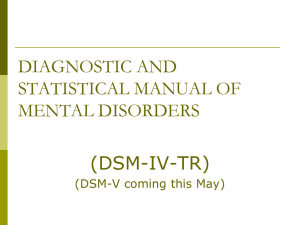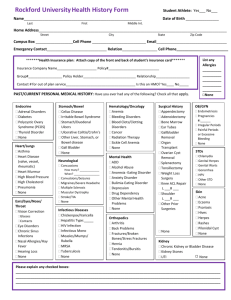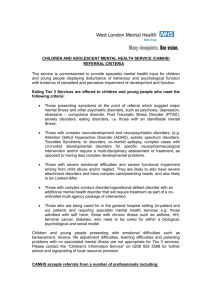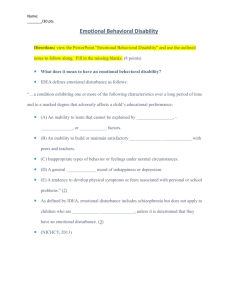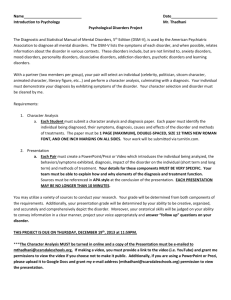xxxxx - Hobbs Municipal Schools
advertisement
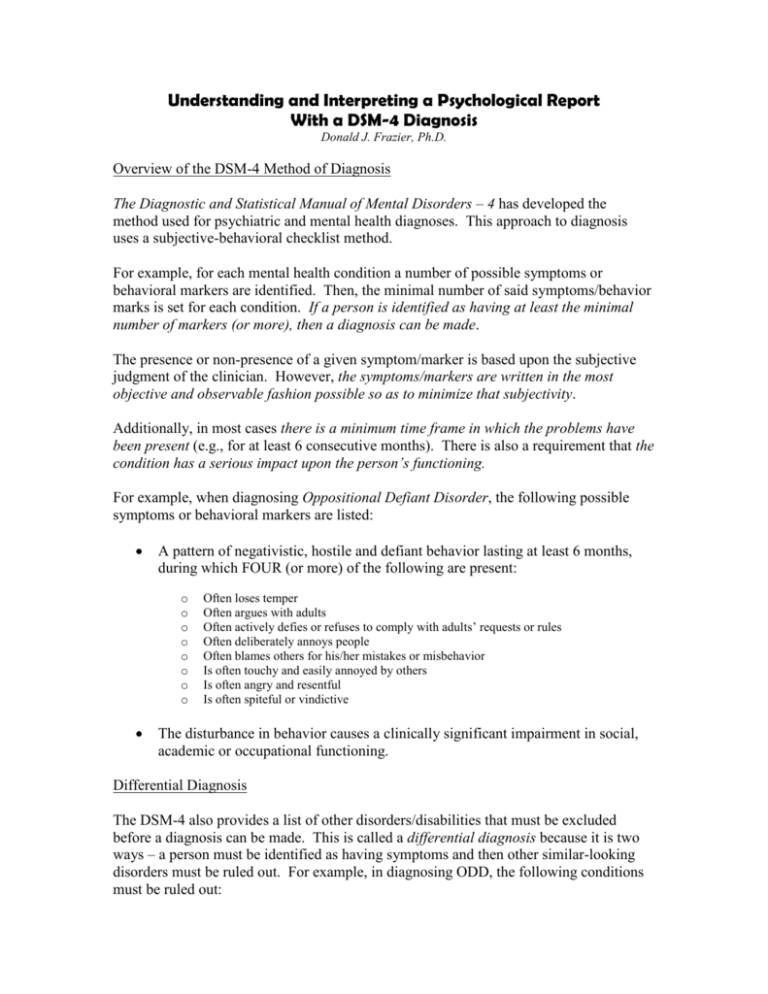
Understanding and Interpreting a Psychological Report With a DSM-4 Diagnosis Donald J. Frazier, Ph.D. Overview of the DSM-4 Method of Diagnosis The Diagnostic and Statistical Manual of Mental Disorders – 4 has developed the method used for psychiatric and mental health diagnoses. This approach to diagnosis uses a subjective-behavioral checklist method. For example, for each mental health condition a number of possible symptoms or behavioral markers are identified. Then, the minimal number of said symptoms/behavior marks is set for each condition. If a person is identified as having at least the minimal number of markers (or more), then a diagnosis can be made. The presence or non-presence of a given symptom/marker is based upon the subjective judgment of the clinician. However, the symptoms/markers are written in the most objective and observable fashion possible so as to minimize that subjectivity. Additionally, in most cases there is a minimum time frame in which the problems have been present (e.g., for at least 6 consecutive months). There is also a requirement that the condition has a serious impact upon the person’s functioning. For example, when diagnosing Oppositional Defiant Disorder, the following possible symptoms or behavioral markers are listed: A pattern of negativistic, hostile and defiant behavior lasting at least 6 months, during which FOUR (or more) of the following are present: o o o o o o o o Often loses temper Often argues with adults Often actively defies or refuses to comply with adults’ requests or rules Often deliberately annoys people Often blames others for his/her mistakes or misbehavior Is often touchy and easily annoyed by others Is often angry and resentful Is often spiteful or vindictive The disturbance in behavior causes a clinically significant impairment in social, academic or occupational functioning. Differential Diagnosis The DSM-4 also provides a list of other disorders/disabilities that must be excluded before a diagnosis can be made. This is called a differential diagnosis because it is two ways – a person must be identified as having symptoms and then other similar-looking disorders must be ruled out. For example, in diagnosing ODD, the following conditions must be ruled out: Page 2 Rule Outs Conduct Disorder Mood Disorder ADHD Intellectual Disability Receptive language impairment 5 Factor Model of Diagnosis The DSM-4 uses a 5 factor model. This reflects a 5 dimensional view of the person being diagnosed. Each of the factors, called Axes, are listed below: Axis I = Psychiatric Condition (list the particular type) Axis II = Special Factors (Intellectual Disability; Personality Disorders for those 16 and older) Axis III = Health issues that could impact academics, behavior, or emotions Axis IV = Environmental issues that could produce exacerbating stress Axis V = Global Assessment of Functioning Each of the five Axes from the DSM-4 are expounded upon in the following sections: AXIS I: Psychiatric or mental health conditions DISORDERS USUALLY FIRST DIAGNOSED IN CHILDHOOD Learning Disorders = Reading, Math, Writing Expression, Motor (fine/gross), Communication (articulation/expressive/receptive) Feeding Disorders = Pica, Rumination, Feeding Disorder Elimination Disorders = Enuresis, Encopresis, Attachment Disorders = Reactive Attachment Disorder (disinhibited and inhibited subtypes), Separation Anxiety Disorder Tic Disorders = Tourette’s, Chronic Vocal/Motor Tic, Transient Vocal/Motor Tic Disruptive Behavior Disorders = ADHD (Inattentive, Hyperactive/Impulsive, Combined Types), Oppositional-Defiant, Conduct Disorder Pervasive Developmental Disorders = Asperger’s, Pervasive Developmental Disorder Not Otherwise Specified, Autism) Other Disorders = Selective Mutism DISORDERS RELATED TO BRAIN DISEASE/INJURY OR ADDICTION Delirium = Due to medical condition, substance abuse, withdrawal, multiple causes) Dementia = Alzheimer’s, Vascular Dementia, Dementia due to medical condition, Amnestic disorders (memory loss) Substance Abuse/Dependence = caffeine, nicotine, alcohol, cannabis, amphetamine, hallucinogen, inhalant, cocaine, opioid, PCP, sedatives Page 3 **THOUGHT DISORDERS (PROBLEMS WITH REALITY CONTACT) Schizophrenia = paranoid, disorganized, catatonic, residual, undifferentiated Delusional Disorder = schizophrenoform, delusional , brief psychotic episode, shared psychotic disorder, substance induced **MOOD DISORDERS Major Depressive Disorder = single episode, recurrent, Dysthymic Disorder = chronic mild to moderate low mood (not severe) Bipolar Disorder = single/recurrent episodes, rapid/slow cycling, most recent episode was manic/hypomanic/depressed episode, s disorder, with psychotic features, with paranoid features **ANXIETY DISORDERS Panic Disorder = with/without agoraphobia, situation-specific Agorophobia = fear of open spaces with/without panic features Social = fear of social groups that can be generalized or specific Obsessive-Compulsive = obsessive, compulsive, mixed obsessive/compulsive types Acute Stress = stress-related single episode Generalized Anxiety = free floating anxiety Somatoform Disorders = somatization, body dysmorphic, hypochrondriasis, pain disorder, conversion disorder Post-Traumatic Stress Disorder = acute/chronic, immediate/delayed onset Dissociative Disorder = dissociative amnesia, dissociative fugue, dissociative identity disorder, depersonalization disorder Factitious Disorder = predominantly psychological/physical symptoms that have no biological basis (and possible secondary gain) Anxiety Due to Substance Abuse or Medical Condition SEXUAL AND GENDER IDENTITY DISORDERS Sexual Desire Disorder = hypoactive/hyperactive sexual desire, arousal/orgasm disorders, sexual pain disorders, erectile dysfunction, substance induced desire problems Gender Identity = onset during childhood/adolescence/adulthood, unwanted homosexuality Paraphilias = exhibitionism, fetishism, frotteurism, pedophilia, masochism/sadism, transvestitism, voyeurism EATING DISORDERS Anorexia Nervosa = restrictive diet versus bingeing-purging type Bulimia = bingeing-urging type Eating Disorder Not Otherwise Specified = overeating, binge eating, eating unusual things Page 4 SLEEP DISORDERS Insomnia = difficulty falling/staying asleep Hypersomnia = excessive sleep, falling asleep at inappropriate times Parasomnia = nightmare or night terror, sleepwalking disorder IMPULSE-CONTROL DISORDERS Intermittent Explosive = serious temper eruptions Kleptomania = compulsion to steal Pyromania = compulsion to start fires Pathological Gambling = compulsion to engage in risk-taking behavior Trichotillmania = compulsive hair pulling ADJUSTMENT DISORDERS Adjustment Disorder = with depression/anxiety/mixed features (must be 6 months or less and temporary) AXIS II: Intellectual Disability and Personality Disorders INTELLECTUAL Intellectual Functioning Intellectually Disabled = IQ score less than 71 or SEM DISORDERS Adaptive Functioning *Broad or specific adaptive functioning scale score of 70 or less consideration indicates significantly low range score * = specific to educational diagnosis PERSONALITY DISORDERS – 16 or older Paranoid = preoccupied with doubts about loyalty, holds grudges, reluctant to confide in others, reads hidden meaning into messages from others Schizoid = socially isolated, lacks pleasure in activities, indifferent to praise/criticism, emotional detachment Schizotypal = magical thinking, ideas of reference, eccentric or odd behavior, paranoid ideation, socially isolated Antisocial = failure to conform to social norms, deceitful, impulsive, disregard for safety issues, consistent irresponsibility, lack of remorse, lack of empathy Borderline = pattern of intense/unstable relationships, identity disturbance, impulsivity, affective instability, suicidal behavior, frantic efforts to avoid abandonment, intense anger, paranoid thinking Histrionic = needs to be the center of attention, seductive/manipulative quality to social interactions, drama enjoyment, shallow emotional expression, exaggerated speech/body language while talking Narcissistic = grandiose sense of self, sense of entitlement, pre-occupied with fantasies of grandeur, lacks empathy, highly focused upon envy, arrogant/haughty behavior, interpersonally exploitive Avoidant = avoids occupations that involve contact with others, excessive fears of rejection/disapproval, excessive fear of being ridiculed, self-view is socially inept and unappealing to others, reluctant to take any social risks Dependent = has difficulty making decisions, has difficulty expressing disagreement, lacks self-initiative, feels helpless when alone or without guidance source, requires excessive reassurance, focused upon possible abandonment Obsessive-Compulsive = preoccupied with rules/lists/order/organization/schedules, over-conscientious, inflexible, reluctant to delegate, excessively devoted to work, rigidity, stubborn Page 5 AXIS III: Health Problems Any health condition that might impact general functioning, academic/occupational performance or social relationships could be considered a significant factor. AXIS IV: Environmental Stressors problems with primary support group problems related to the social environment educational/occupational problems housing problems economic problems problems with access to health care problems related to interaction with the legal system other psycho-social or environment problems AXIS V: Global Assessment of Functioning (1-100) 90-100 = excellent functioning 80-89 = absent or minimal symptoms, high level functioning 70-79 = transient or expected symptoms, generally effective functioning 60-69 = mild symptoms or difficulties 50-59 = moderate symptoms or difficulties ------------------------------------------------------------------------------------------ 40-49 = generally low functioning and/or problems with reality testing 30-39 = major impairment in at least one aspect of life 20-29 = severe impairment in at least one aspect of life or as having a major impairment in several different areas 10-20 = clear and obvious danger to self or others, severe self-care problems 0-09 = Severely low functioning and high danger to self/others Page 6 EXAMPLES Example 1: 14 year old female 9th grade student with generally strong grades AXIS I: AXIS V: Major Depressive Disorder (single episode, severe with suicidal ideation, without psychotic features) None Diabetes Recent breakup from long-time boyfriend; strained relationship with parents; social isolation from friends at school 45 at admission, 65 at discharge Example 2: 3 year old male pre-school student who has received Part C (birth to 3) services AXIS I: AXIS II: AXIS III: AXIS IV: AXIS V: Autistic Disorder Rule Out Mental Retardation (Intellectual Disability) Asthma Problems with social relations 40 by historical report over past year Example 3: 12 year old male student who has been suspended for bringing a knife to school and who has recently sought out counseling AXIS I: Oppositional-Defiant Disorder Attention Deficit Disorder (Hyperactive-Impulsive Type) Cannabis Abuse (by history, in remission) Alcohol Abuse (by history, in remission) Victim of Childhood Physical Abuse (by history, from ages 4 to 7) None Childhood Obesity, Hearing loss in left ear Problems with conflict in relation to parents, siblings and peers; parental drug/alcohol abuse; on probation for breaking and entering 55 AXIS II: AXIS III: AXIS IV: AXIS II: AXIS III: AXIS IV: AXIS V: Example 4: 16 year old female student who has recently been hospitalized for a severe eating disorder and frequent absences from school due to “illnesses.” AXIS I: Hypochondriasis (with poor insight) Body Dysmorphic Disorder Bulimic Disorder Histrionic Acid Reflux Disorder (resulting from frequent self-induced purging episodes) Problems relating to parents; educational problems (excessive absenteeism) 45 to 58 (past year, by report) AXIS II: AXIS III: AXIS IV: AXIS V: EXAMPLE 5: 17 year old student who has been hospitalized 4 times in the past 11 months due to severe hallucinations and delusions (telling him to hurt himself or others) AXIS I: Schizophrenia (disorganized type, severe) Page 7 Distinguishing Emotional Disturbance from Social Maladjustment Emotional Disturbance When one uses the term Emotional Disturbance, it refers to those psychiatric conditions that reflect a disorder in affect or emotion. That is, some type of dysfunction in emotional self-regulation must be at play in order for this educational diagnosis to be considered. In many cases, the affective conditions (depression, anxiety, bipolar) have a bio-neurological foundation. As such, psychotropic medication is often used as a first line of symptom management. It is important to remember that there must be a serious or severe impact for an educational diagnosis to be considered. If not, a Section 504 plan may be the preferred alternative route to intervention. Generally speaking, then, the special education category of Emotional Disturbance may be relevant when one is presented with information that suggests a student has been diagnosed with a Mood Disorder, Anxiety Disorder or Thought Disorder with severe impact. In terms of making an educational diagnosis, there must be a severe academic or social disruption from the diagnosed affective disorder. Thought disorders (schizophrenia, etc.) with severe impact are also included under the general Emotional Disturbance umbrella because the hallmark symptoms (hallucinations, delusions, bizarre behavior, social isolation) can result in serious emotional disruption in the individual. Social Maladjustment Social Maladjustment is the term used to describe negative, disruptive or anti-social behaviors that do not have an affective foundation or cause. Children or teens with a social maladjustment have obtained the problem behaviors primarily through social learning. The primary symptoms involve problems with authority-challenging, rule-breaking, social conflict and impulse control. Recall that federal law specifically identified Impulse Control Disorders and Sexual Disorders as not reflecting a mental disability, while Mood Disorders and Thought Disorders were considered as such. Similarly, in the school setting, the differentiation of emotional disability versus social maladjustment is reflected in a similar fashion. There is still no clear agreement as to whether or not social maladjustment conditions can qualify for a Section 504 plan. This often varies from district to district and state to state. Emotional disabilities often have been shown to have genetic or neuro-chemical etiology and thus often are managed through psychotropic medication. Conversely, social maladjustment conditions do not have large research bases reflecting genetic or neuro-chemical correlates. The behavioral signs of these conditions are often the product of environment, socialization practices, reinforcement histories and secondary gain. The problems with students who have “social maladjustment” can be as serious as those reflected by Emotional Disturbance. Students with these problems will likely require Tier 2 interventions, at least. Page 8 Conduct Disorder A repetitive and persistent pattern of behavior in which the basic rights of others or major age-appropriate norms or rules are violated, as evidenced by 3 or more of the following criteria for a period of 12 months and 1 or more of the following criteria for at least 6 months: Aggression to people and animals Often bullies, threatens or intimidates others Often initiates physical fights Has used a weapon that can cause serious physical harm to others Has been physically cruel to people Has been physically cruel to animals Has stole while confronting a victim Has forced someone into sexual activity Destruction of property Has deliberately engaged in fire setting with the intention of causing serious damage Has deliberately destroyed other people’s property (other than by fire setting) Deceitfulness or theft Has broken into someone else’s house, building or car Often lies to obtain goods or favors or to avoid obligations (i.e., “cons” others) Has stolen items of nontrivial value without confronting a victim Serious violations of rules Often stays out late at night, despite parental prohibitions (beginning before age 13) Has run away from home overnight at least twice while living in parental or surrogate home (or run away once for a lengthy period of time) Is often truant from school, often beginning before age 13 SUBTYPES: Childhood versus Adolescent onset SEVERITY: Mild (minimum number of criteria met, no serious harm to others) Moderate (moderate number of indicators in excess of minimum criteria met) Severe (many indicators present in excess of minimum criteria or serious harm to property/others) Page 9 Methods of Distinction Between Emotional Disability and Social Maladjustment 1. DMS – 4 Diagnosis Emotional Disability = Mood Disorders (depression, anxiety, bipolar) and/or Thought Disorders (schizophrenia) Social Maladjustment = Disruptive Behavior Disorders (Oppositional-Defiant, Conduct Disorder), Impulse Control Disorders (kleptomania, pyromania, intermittent explosive) and/or Sexual Disorders (paraphilias). The behavioral markers of ODD were listed previously in this section. Features of Conduct Disorder from the DSM-4 are listed below. 2. Psychological Testing Results A. Tests that distinguish Internalizing (emotional) from Externalizing (social maladjustment) tendencies (i.e., Behavior Assessment System for Children – 2, Social Skills Rating System, etc.) B. Tests that directly measure emotional factors (Children’s Depression Inventory, Revised Manifest Anxiety Scale for Children, Piers-Harris Self-Concept Test – 2, etc.)


